“Why is my chimney leaking?” is a common question that arises when homeowners encounter water-related issues with their chimneys.
A leaking chimney can lead to structural damage to potential health hazards. In this brief exploration, we will delve into the common causes behind chimney leaks, offering insights into what homeowners can expect and practical steps to address and prevent this issue.
Understanding the reasons behind chimney leaks is crucial for maintaining a safe and efficient home environment.
Why Is Water So Bad for Chimneys?
Brick is commonly used in Portland for traditional fireplaces and chimneys, especially firebrick, which can endure the high temperatures of wood fires. However, there’s a drawback to using brick – it’s naturally porous, meaning part of the chimney is constantly vulnerable to exposure can absorb and hold water. Since chimneys are constantly exposed to the weather, they can take in water from rain, snow, and sleet.
So, what’s the big deal if water gets into my chimney?
Well, water might seem harmless, but for chimneys, it can be quite destructive. Here are a few ways water can cause problems for your chimney:
- Material Breakdowns: When water mixes with soot and creosote inside the chimney, it creates acidic substances that can make your chimney wear down faster.
- The Freeze/Thaw Cycle: If water is trapped in the brick, it freezes when it’s cold and melts when it’s warm. This cycle can make bricks shift and create gaps in the mortar joints, leading to spalling brick and affecting the structural strength of your chimney.
- Rust & Corrosion: Water can cause different parts of your chimney to rust and corrode. If some components are damaged, it can lead to inefficiencies in the entire system, potentially posing risks to your household.
- Efflorescence: Water can bring salts from the brick to the surface, leaving behind white or gray deposits called efflorescence. This is a sign of water damage, and if not treated, it can make the brick chip and flake.
- Mold, Mildew & Vegetation: A musty fireplace smell could indicate the growth of mold and mildew, which thrive in moist environments. These can be harmful to respiratory health. Vegetation growth, while less hazardous, still suggests water entry and a long-term leak.
What Causes Chimney Leaks?

Maintaining a chimney isn’t a one-size-fits-all task. Leaks can happen for various reasons, and during a chimney inspection, we often explore these common culprits:
Masonry problems
Bricks and mortar, though sturdy, can be vulnerable to rain and other elements. Cracks in the bricks or mortar, due to their porous nature, can let water seep into the chimney.
This may result in aesthetic damage like spalling, where the face of the brick pops off. Serious issues may arise, compromising the integrity of your chimney liner.
Flashing problems
Flashing is the metal banding around the part where your chimney meets the roof. It’s crucial for a watertight seal.
Faulty metal flashing, often due to improper installation or aging, can create openings for water entry. Rusty nail holes in the flashing are particularly susceptible.
Cracks in the crown
The chimney crown, the cap at the top of your chimney flue, shields it from water. It’s designed to direct water away. A cracked crown can undermine this purpose, potentially causing your chimney to leak water.
Lack of a chimney cap or cover
A properly-sized chimney cap is essential for preventing water damage, along with keeping out animals, debris, and downdrafts. Investing in these components can save you from future repair bills.
No waterproofing
Waterproofing is a professional service involving the application of a water-resistant sealant on your chimney.
Without this protective layer, your chimney becomes vulnerable to moisture, leading to significant water intake.
What Are The Signs of a Leaking Chimney?
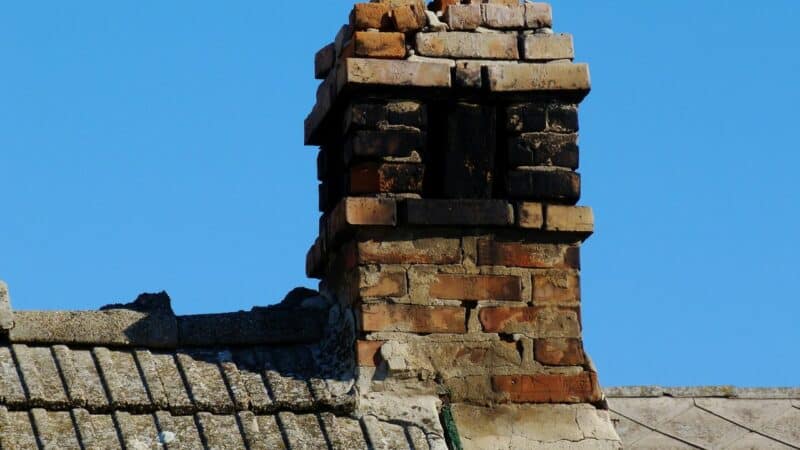
As mentioned earlier, spotting water damage in chimneys often occurs in the later stages.
While annual chimney inspections are the best way to catch leaks early, unforeseen issues can arise between checks. If you observe any of the following signs, it’s advisable to contact professionals promptly:
- The sound of dripping water in your fireplace and/or chimney
- A musty odor coming from your fireplace
- Leaks or water stains on the ceiling and walls near your chimney
- Walls and ceilings that are damp to the touch or have peeling paint
- Clogs or buildup in the flue
- Condensation on the walls of the firebox
- Puddles of water in the firebox
- Mold, mildew, or vegetation growth, appearing as green or black stains
- Signs of discoloration like efflorescence
- Spalling, cracking, or chipping bricks
- Woodwork near your chimney that is soggy or rotting
- Metal parts that are rusting and/or corroding
- Crumbling or flaking mortar
- Damage to the flue liner
Being attentive to these signs and taking swift action when necessary can prevent further damage to your chimney and ensure the safety and efficiency of your fireplace.
What Can Happen if I Don’t Fix My Chimney Leak?

Chimneys quietly play a crucial role in our homes, especially during cozy gatherings or chilly days. While they might be out of sight on most days, ignoring a chimney leak can lead to serious consequences. Here’s what could go wrong if you neglect a leaky chimney:
Damage inside your home:
Water entering the chimney can make its way into your interior walls and ceilings, causing water stains, peeling paint, and potential damage to nearby furniture.
Mold and mildew growth:
A leaky chimney creates a damp environment, perfect for mold and mildew to thrive. This poses a risk to your home’s air quality and increases the chance of respiratory illnesses for you and your loved ones.
Flue liner deterioration:
Leaks can damage the flue liner, affecting its ability to contain heat and redirect harmful combustion byproducts like carbon monoxide. A damaged flue liner requires prompt replacement and repair.
Increased risk of fire:
Cracks and gaps in the chimney structure, caused by water damage, can allow heat to escape and potentially ignite nearby woodwork or combustible materials, increasing the risk of a fire.
Decrease in efficiency:
A leaky chimney won’t function as efficiently. Starting and maintaining a fire may become challenging, and you might not get the expected heat output.
Lowered property value:
Neglected chimney maintenance can impact your ability to sell your home. Many buyers request a chimney inspection, and if your chimney doesn’t pass, it could hinder the sale.
Structural damage:
Water is highly destructive to brick and mortar. Untreated leaks can lead to deterioration, chimney cracks, and wood rot which weakens the chimney’s structure over time. This can result in cracks, crumbling, and even a collapse.
How Do I Prevent Chimney Leaks?

Now that we’ve covered the potential challenges, here’s the silver lining: by combining regular chimney inspections, chimney sweepings, and routine maintenance, you can prevent chimney leaks. Portland Fireplace and Chimney is here to help with a range of services tailored to address chimney leaks proactively or fix existing issues.
Here are some key steps to keep your chimney in top shape:
Don’t skip annual inspections
Schedule an inspection by a Chimney Safety Institute of America (CSIA) certified technician. It’s a straightforward way to assess the condition of your chimney. Combine it with a chimney sweeping for a comprehensive maintenance weekend.
Install a chimney cap
A chimney cap is a simple but effective solution to prevent water, debris, and animals from entering your chimney. It closes the opening while still allowing smoke and fumes to safely exit. Having a proper chimney cap is an often recommended safety strategy recommended by the Chimney Safety Institute of America.
Consider a chimney crown or chase top
Invest in a chimney crown made of concrete or mortar at the top of your chimney to shield it from water, animals, and debris. A chase top, typically made of metal, serves a similar purpose, especially for prefab chimneys.
Professional flashing installation
Vulnerable areas where your chimney meets the roof can be sealed effectively with flashing. This layered metal protection prevents water from entering, safeguarding your chimney.
Ask about a chimney cricket
If your chimney is wider than 30 inches, inquire about installing a chimney cricket. This miniature peaked roof, positioned behind your chimney, prevents water from pooling and redirects it back down to your roof.
Prompt repair work
If you suspect an issue between annual inspections, don’t hesitate to reach out. Lords Chimney can send a sweep to investigate and address the problem before it escalates.
Don’t Forget Waterproofing
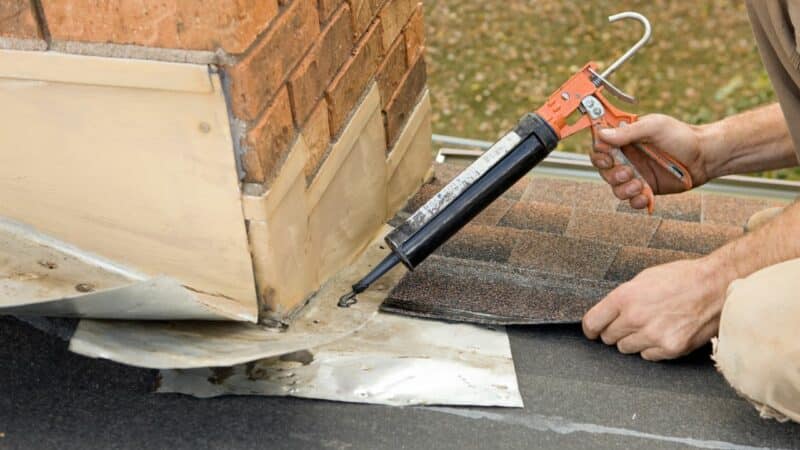
Remember to waterproof your chimney. It’s an important step to keep water out and protect your chimney from damage. Using a water repellent helps prevent issues like water absorption, cracks, discoloration, and problems during freeze/thaw cycles. So, don’t forget about waterproofing to keep your chimney in good shape.
Here’s what waterproofing accomplishes:
- Blocks water absorption in your brick and mortar: Creates a protective barrier to prevent water from seeping into the porous surfaces of your chimney’s brick and mortar.
- Keeps your brick and mortar from cracking, spalling, and/or gapping: Preserves the structural integrity of your chimney by avoiding common issues such as cracking, spalling (surface flaking), and gapping.
- Protects your masonry from unsightly discoloration: Safeguards the appearance of your chimney by preventing water-related discoloration and staining on the brick and mortar.
- Allows your brick and mortar to “breathe” and release water vapors: While blocking water entry, the treatment permits the release of water vapors from the inside, maintaining a balanced and healthy environment for your chimney.
- Prevents damage following a freeze/thaw cycle: Especially effective in regions with varying temperatures, waterproofing helps avoid damage caused by the freeze/thaw cycle, where water expands upon freezing, potentially causing structural damage.
Can I fix a Chimney Leak myself, or Should I Get Professional Help?
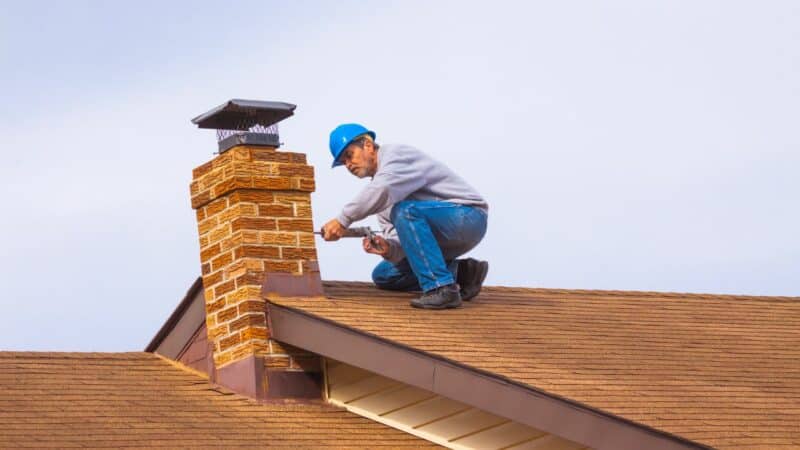
If the chimney leak is small and you feel confident, you can try fixing it yourself with special sealant or caulk. But if the leak is big, or you’re not sure what’s causing it, it’s usually better to ask a professional for help.
Professionals know how to check everything carefully, use the right materials, and make sure the problem is fixed properly. They can give a long-lasting solution, especially for big or tricky issues. If you have any concerns about safety especially with something as essential as your chimney it’s always best to find a professional (like us) to help with your Chimney.
Call Portland Fireplace & Chimney for all your Chimney Problems!
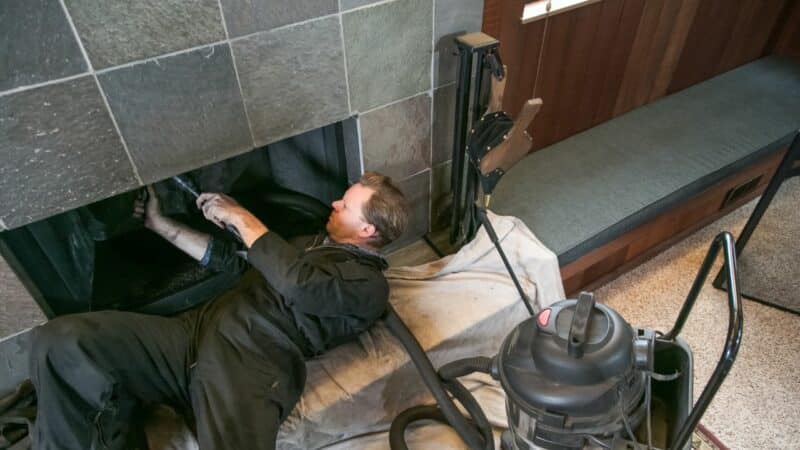
Encountering a leak in your chimney can be more than a minor inconvenience; it could signal deeper, structural issues within your chimney system. But fret not: Portland Fireplace & Chimney is your trusted ally in diagnosing and resolving chimney leaks with precision and care.
Our comprehensive approach to repairing your chimney leak includes:
- A thorough inspection to pinpoint the exact cause of the leak.
- Expert recommendations for repair or replacement of compromised components.
- Professional execution of necessary repairs, ensuring the longevity and safety of your chimney.
Whether it’s sealing a simple crack or overhauling your entire chimney system, you can count on Portland Fireplace & Chimney to address your concerns with expertise. Don’t let a chimney leak dampen your spirits: Reach out to us, and we’ll ensure a warm, dry, and secure hearth for your home.
Frequently Asked Questions
How much does it cost to fix a leaky chimney?
The cost to fix a leaky chimney can vary greatly, depending on the severity of the leak and the necessary repairs, with prices generally ranging from a couple of hundred dollars for minor repairs to a few thousand for extensive fixes. Identifying the exact problem—whether it’s due to issues with the flashing, cap, crown, or masonry—will help determine a more accurate cost estimate.
Are chimney leaks covered by homeowners insurance?
Chimney leaks may be covered by homeowners insurance if the damage is sudden and accidental, like storm damage, but they typically won’t cover issues from wear and tear or lack of maintenance. It’s always wise to check your individual insurance policy or speak with your insurance company for the specifics of your coverage.
Why is water so bad for chimneys?
Water is a chimney’s hidden nemesis; it’s highly destructive because it can penetrate the porous masonry, causing erosion, spalling, and even mold or mildew issues. Secondly, when water mixes with soot and creosote, it forms acids that further damage the chimney flue and structural integrity, leading to costly repairs.
My chimney leaks when it rains; is that normal?
Not at all, it’s far from normal for your chimney to leak when it rains. This could indicate issues with your chimney cap, flashing, or even the masonry itself. It’s important to address this promptly to prevent further damage.
How long does it take to fix a chimney leak?
The time to fix a chimney leak can vary, but typically a straightforward repair can be completed within a few hours. If the damage is extensive, such as requiring a rebuild of the chimney structure or addressing related water damage in the home, it might take several days to properly resolve the issue.
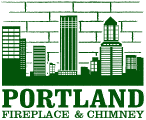
Portland Fireplace and Chimney Inc is your top notch pick for a fireplace and chimney company in the greater Portland metro area.

